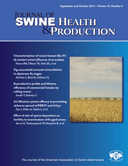Abstract:

Reproductive profile and lifetime efficiency of female pigs by culling reason in high-performing commercial breeding herds
Yosuke Sasaki, BSc, MSc; Yuzo Koketsu, BVSc, MVSc, PhD
Complete article is available online.
PDF version is available online.
Objectives: To compare lifetime efficiency and by-parity reproductive performance of female pigs categorized by culling reason or herd productivity group.
Materials and methods: Lifetime records were analyzed for 62,775 females in 101 Japanese commercial herds. Culling reasons were categorized into four groups. Three herd groups were based on the upper and lower 25th percentiles of pigs weaned per mated female per year: high-, intermediate-, and low-performing herds. Annualized lifetime pigs born alive (PBA) was calculated as the sum of PBA in the sow’s lifetime ÷ female life-days × 365 days. Multilevel linear mixed-effects models were performed to compare measurements by subgroups.
Results: Females culled for “reproductive failure” had 7.5 pigs fewer annualized lifetime PBA and 43.0 more lifetime nonproductive days than those culled for “high parity” (P < .01). Females culled for reproductive failure in high-performing herds had 34.7 fewer lifetime nonproductive days than those in low-performing herds (P < .01), but lifetime PBA was similar to those in the other herd groups. Females culled for reproductive failure had a longer weaning-to-first-mating interval and lower farrowing percentage from parity 1 to 4 than those culled for “high parity” (P < .01), but PBA values were similar to those in other parity groups. Females culled for “locomotor problems” had 0.3 pigs more annualized lifetime PBA than those culled for reproductive failure (P < .01).
Implications: It is critical to decrease nonproductive days in each parity of females with reproductive problems in order to increase sow lifetime efficiency.
Keywords: lameness, longevity, reproductive failure, well-being
![]() Cite as: Sasaki Y, Koketsu Y. Reproductive profile and lifetime efficiency of female pigs by culling reason in high-performing commercial breeding herds. J Swine Health Prod 2011;19(5):284-291.
Cite as: Sasaki Y, Koketsu Y. Reproductive profile and lifetime efficiency of female pigs by culling reason in high-performing commercial breeding herds. J Swine Health Prod 2011;19(5):284-291.
Search the AASV web site for pages with similar keywords.
